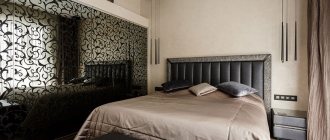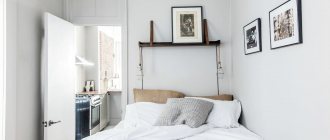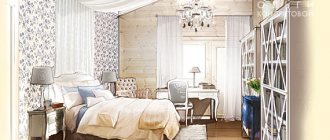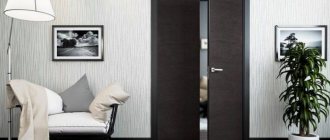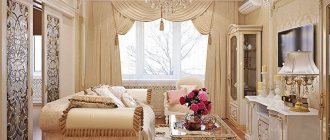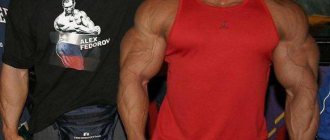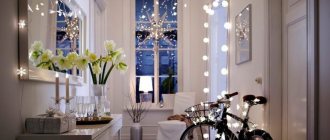An artist’s studio should, first of all, be cozy and comfortable.
- Frame pool on site, water treatment and maintenance
Read
Artists are creative individuals, for whom the atmosphere and environment play a huge role: even a slight resonance in the interior can frighten off the Muse and inspiration will instantly disappear. Therefore, you need to approach creating a workplace as thoughtfully as possible, working out every detail.
The workshop should have both artificial and natural lighting
Studio in a separate room
The best solution when creating a workplace for a creative person is a separate room. Ideally, this is an extension, garage or attic. Distance from loved ones will allow you to completely immerse yourself in work, without being distracted by noise and conversations. In addition, when working with paint, it is easy to stain furniture and walls. Therefore, the studio interior should include various nuances.
Art studio in a separate building
Workshop interior in rustic style
When planning to place a workplace in a studio, it is worth considering one of the main criteria - location. Traditionally, the north side is a good option - as an example of the most natural lighting. The absence of direct sunlight creates diffused light, and the combination with electricity is identical to art gallery lighting. Another interesting solution would be to place windows facing northwest. The setting sun in the evenings will paint the workshop with a rich palette of colors, which will become an additional source of inspiration.
Advice! If it is not possible to sit on the north side, you can use hatches and windows built into the roof.
It is advisable to make the most of natural light, shading direct rays if necessary. The attic is ideal for such purposes. You just need to solve the issue of heating, ventilation and take care of the interior lining so that valuable materials are not damaged.
1
4
Advice! A studio in an attic or loft has its advantages. The highest wall under the roof can be used to store large canvases.
According to most artists, the best option for a workshop is a room with access to an open space. This could be a garden, yard or street. Working on the terrace in beautiful weather will give you unity with nature and expand your creative horizons. If space allows, you can make access to a covered area. Thus, you can create masterpieces even in inclement weather.
Spacious studio with large balcony
Corner in the apartment
Having a spare garage or shed that you can turn into a studio is great, but not everyone has that ability. Moreover, for an “urban” artist, working and living in a metropolis can be a prerequisite. You can equip a place in your apartment just as well, just follow a few rules.
Even in a small apartment you can create a comfortable workplace for creative work.
Zoning space using a glass partition
To create a creative corner, it is better to pay attention to the living room or dining room instead of the bedroom. You'll need space to store your canvases, brushes, and easel, so you'll need to consider the space when planning. The room should be dry and bright.
Important! In an apartment, like in a studio, the north side is a priority: this arrangement of windows will provide even, uniform light. You won’t be able to do without artificial lighting: lamps will be needed in the evening or for additional illumination of the model.
The color of the walls plays an important role, because the room should give the effect of free space. Bright or dark colors would be a bad choice, as they will distract attention and deprive the room of light. Light colors work best, especially for limited spaces. White ceiling and walls are an excellent solution for an area of any size. When choosing a floor covering, it is better to focus on the practicality of the material (tile, linoleum or laminate). Color fades into the background, but simple and quick cleaning of the studio is a must.
1
4
Advice! If the area is not enough, a mobile easel will help save some space. Its versatility will come in handy both in and outside the studio.
A small easel will help save useful space
Studio apartment with work area
Choosing furniture will not take much time, since this is not the most important thing for an artist’s workplace. Most of the space will be occupied by shelves, where all working tools can be freely placed. You may also need a chest of drawers or a coffee table to store paperwork.
It is better to select special equipment in the form of easels, customizable brackets and a working surface “for yourself”, focusing on the convenience and functionality of the items.
A separate room is an ideal option for setting up an art workshop
The permanent exhibition “Jacques Lipchitz's Room”, consisting of ten sculptures and six drawings, opened at the State Hermitage in December. The museum's contemporary art department prepared this project for the upcoming 125th anniversary of the birth of the French-American sculptor, a native of the town of Druskeniki, Alytus district, Grodno province. Lechaim could not ignore these events.
Jacques Lipchitz. Inspiration. 1955. Hermitage. Gift of the Jacques and Yulla Lipchitz Foundation
The artistic method of the sculptor Jacques Lipchitz was built, according to the classical tradition, in several stages. The graphic sketch was reproduced in clay, then developed in plaster, and only after that was cast in bronze or carved from stone. Juggling with materials and familiar techniques, Lipchitz experimented with new forms in order to express himself on eternal themes in a different plastic language. “The Lipchitz Room,” thanks to a gift from the sculptor’s family—the Jacques and Yulla Lipchitz Foundation (New York), which appeared at the end of the enfilade of the General Staff Building, reflects the diversity of the master’s work: in “Yaakov and the Angel” (plaster, 1931), the influence of Cubism is noticeable; the late piece “Inspiration” (plaster, 1955) was created using a technique that Lipschitz called “semi-automaticism”; “Portrait of Theodore Géricault” (plaster, 1933) and a plaster model of the bust of President John F. Kennedy (1964–1965), installed in Newark, New Jersey, are works of maximum realism.
Thanks to the intimate nature of the things, which can be considered preparatory sketches, the attentive viewer can immerse himself in the “holy of holies,” the laboratory of a tireless experimenter and outstanding sculptor of the century. As the project curator, head of the Hermitage’s contemporary art department, Dmitry Ozerkov, rightly noted: “We chose plaster originals for the museum collection, because this is the material that the sculptor touches with his hands, it is, in the literal sense of the word, the imprint of the master’s hand.”
Lipschitz's early years largely rhyme with the fates of Jewish artists who came from the Pale of Settlement and the western provinces of the Russian Empire. The slight difference in trajectories seemed to depend only on the income of their families. Chaim Yakov Lipshitz was born on August 22, 1891. His grandfather, a major industrialist from Grodno Shaya-David Peisakhovich Lipshits, was against the marriage of his son Abram Yitzchak. He was shocked by the poverty of the parents of his chosen one, the beautiful Leah-Rachel Krinskaya. In turn, the Krinskys did not welcome this marriage due to the Lipshits’ lack of religiosity. But the wedding did take place. The young people settled in Druskeniki on the banks of the Neman, in a large wooden house, where today the Jacques Lipchitz Memorial Museum is located. Abram Lipshits, who did not receive a special education, but had a taste and was partly related to the artistic profession, made money from architecture and construction, although, in fact, he could be called a contractor. Having received a government order, he worked on the building project, hired workers, purchased building materials and handed over the finished house to the client on a turnkey basis. It is known that Abram Lipshitz’s company built stations in Zhmerinka and Druskeniki. The sculptor’s father also had a hand in the construction of the hotel in present-day Druskininkai on St. Jakub Street.
The Lipshits had six children - sons Pinya and Reuben, daughters Zhenya, Fanya, Dina. Chaim Yakov is the firstborn. Studying at the cheder was followed by a commercial school in Bialystok, Poland, and a gymnasium in Vilna. I studied very poorly. Yakov Lipshitz was drawn to painting, which his father, of course, was not delighted with. Lipchitz’s mother (I remember Marc Chagall’s mother, who took the boy to art school with Yehuda Pan with the words “yes, son, I see you have talent”) supported her son in his aspirations. Having secretly pawned diamond earrings, Rachel provided Jacob with funds for a trip to Paris, where he departed in 1909. And Abram Lipshits himself, having cooled down, began to help his son financially. For two years Jacob, now Jacques, having chosen the art of sculpture, studies at the Academy of Fine Arts, in the workshop of the sculptor Jean-Antoine Injalbert, attends sculpture classes in private schools Filippo Colarossi and Rodolphe Julian, gets acquainted with the inhabitants of the famous art colony “Beehive”, but all still renting a hotel room. In those days, a young man could even afford the luxury of collecting. Like many artists of that time, he was attracted by African art, the rough forms of archaic sculptures and ritual masks. The very idea of primitivism and simplification, perceived by experimenters in art, gave rise to the avant-garde phenomenon called cubism, the programmatic work of which, “Les Demoiselles d’Avignon” by Pablo Picasso, also a famous admirer of the African style, was created in 1907, and its exhibition was accompanied by a scandal.
Jacques Lipchitz.
Sailor with a guitar. 1917–1918. Center Georges Pompidou The fateful meeting of Lipchitz with this subverter of foundations, however, was still ahead - in 1913 they would be introduced to the Mexican Diego Rivera.
By that time, Abram Lipshitz will go bankrupt, and Yakov will suffer from tuberculosis. He will have time to visit home and go to St. Petersburg - for exemption, for medical reasons, from army service. In the capital, he will look into the Hermitage and will be delighted to see the halls of Scythian art. And upon returning to Paris, he would settle at 54 Montparnasse, renting a workshop next door to Brancusi. And yes, Lipchitz remained faithful to the classics at the threshold of the Autumn Salon, where in 1913 he received a prize for the sculpture “Woman with Gazelle”. Works from 1914 to 1918 (“Head”, “Guitar Player”, “Figure”, “Acrobat on a Horse”, “Bather”, “Sailor with a Guitar”) already demonstrate a complete liberation from salon layers, a readiness for experimentation, and a radical change in strategy. Harmonious agreement with the world evolves in Jacques Lipchitz into the destruction of simplified forms, the disturbing rhythm of sharp edges, dynamic planes superimposed on each other, heightened constructiveness, freedom from life-likeness. One of the first (Ossip Zadkine and Alexander Archipenko were searching in the same direction) he translates cubist painting into sculpture and, giving flesh, gives the canvas a chance to gain three-dimensionality. Lipchitz himself would later call this period “naive cubism.” In 1915, he met the poetess Bertha Kitrosser, a native of the city of Soroca, in Bessarabia. In Paris, she works part-time as a model; she is painted by Gris and Rivera. Together with her little son Andrei, Berta Moiseevna leaves her husband, Colonel Vladimir Shimkevich, for Lipshits. Their friend Amedeo Modigliani painted a double portrait of Jacques Lipchitz and his wife Berthe (now in the collection of the Art Institute of Chicago). The work is considered a wedding gift, although the marriage was officially concluded only in 1925, when Jacques received French citizenship.
In the 1920s, success came to Lipshitz (he, as Abram Efros wrote, was met “”), accompanied by financial independence. Previously, I had to earn extra money as a fruit delivery boy and as an apprentice to other sculptors. It is worth remembering: sculpture requires not only incredible physical, but also material costs. Lipchitz is becoming fashionable and professionally in demand. His tastes coincide with the times when a new style, Art Deco, is already marching victoriously.
Lipchitz's first solo exhibition opens at the Marchand Léonce Rosenberg gallery on Rue de La Baume. The famous critic and promoter of Cubism, Maurice Raynal, publishes a monograph about the young sculptor. Lipchitz works on a portrait of Coco Chanel and forged elements for the interior of her house and garden, right down to the firewood stand, the curved linear motif of which, oddly enough, influenced the further creative searches of the sculptor. Collector Albert Barnes commissions him to create five stone reliefs for the façade of his mansion in Pennsylvania. Lipschitz himself now has his own home. A three-story house with a workshop on the edge of the Bois de Boulogne (9, allée des Pins - a monument was erected nearby in 1991, on the centenary of Lipchitz’s birth) is being designed for him by his friend, the architect Le Corbusier. During these same years, Lipchitz experimented with emptiness in chamber and monumental sculpture, creating so-called transparent sculptures. His searches related to the transmission of dynamic expression through the interpenetration of abstract figures, holes, niches and gaping gaps (“Harper”, “Couple”) greatly influenced the development of modernist sculpture of the mid-20th century. By the way, Lipchitz also attached great importance to light, as an integral part of sculpture, to the play of planes.
Jacques Lipchitz.
Inspiration. 1955. Hermitage. Gift of the Jacques and Yulla Lipchitz Foundation In an interview with the Thing magazine, the sculptor explained: “With the help of volumes I draw light.
The utility of the sculpture is here. It gives the measure of the human “I” and his poetic knowledge of the universe.” It is believed that with the work “The Joy of Life” of 1927, the sculptor summed up the results of cubism and moved on to expressionism. The deformation of nature filled his new works with emotional imagery. The themes that increasingly concern Lipchitz are human relationships, struggle and redemption, and he predictably turns to mythological and biblical subjects: Jacob and the Angel, David and Goliath, The Rape of Europa, Leda, Prometheus . In the 1930s, the sculptor was on the editorial board of the pro-Soviet art magazine “Udar,” created by Sergei Romov. (In addition to Lipshitz, Ehrenburg and Lunacharsky are listed there.) And in 1935 he went to Moscow. He hoped to decorate the building designed by Corbusier with his works. But he received an order for a sculpture (its plaster copy is in the collection of the Pushkin State Museum of Fine Arts). He doesn’t come to the USSR anymore. In 1937, the French government commissioned Lipchitz to create a monumental sculpture for the World Exhibition in Paris, and his “Prometheus Strangling the Eagle” crowned the Palace of Science and Invention. The occupation of Paris disturbs Lipchitz: he flees to Toulouse in May 1940. His brother Reuben remains in Paris. A year younger than Jacques, he came to Paris after him, was in the Resistance throughout the war and saved the sculptures by burying them in the courtyard of the workshop. Subsequently, it was to Reuben, his confidant in European affairs, that Jacques would give a large series of works, which he would donate to Israel before his death. As the brothers’ niece writes, Reuben “...said that he did not want his brother’s sculptures to go into private hands.”
And Jacques himself would briefly appear in France in 1946 to receive the Order of the Legion of Honor and return to America again, only without Bertha. The couple separates. In 1948, in New York, Jacques married Ylla Halberstadt, also a sculptor. In the same year, their daughter Lolia Rachelle is born.
Jacques Lipchitz.
Hagar II. 1949. Gallery “Univers du Bronze”. Paris With the figure of the “Miracle”, with the tablets of the Testament raised above his head and a lit menorah, Lipchitz welcomes the revival of the Jewish state.
The creation of Israel was in many ways a defining event for him. The second half of Lipchitz's life is filled with the light of recognition, new experiments and spiritual quests. In France, near the church in the village of Assy, his sculpture “Holy Virgin” is installed with the signature on the pedestal: “Jacques Lipchitz, a Jew, faithful to the religion of his fathers, sculpted this Holy Virgin to encourage the life of the spirit, which gives man mutual understanding with his neighbors.” In 1954, a major retrospective of Lipchitz was held at MoMA in New York. There, in New York, the entrance to the building of Columbia University is decorated with Lipchitz’s sculptural group “Bellerophon pacifying Pegasus.”
In 1965, the famous sculptor came to Jerusalem at the invitation of the Israeli government. In 1971, his first exhibition took place in Tel Aviv. “I feel that I belong to the Holy Land,” the author admits, donates many of his works to Israel and begins work on “The Tree of Life.” The location for it has already been chosen - the territory of the Hadassah hospital on Mount Scopus. In Jerusalem, on the Mount of Olives, Chaim Yakov (Jacques) Lipchitz, who died on May 23, 1973 in Capri, bequeathed to be buried.
* * *
Unlike many former compatriots and fellow believers, Jacques Lipchitz received full glory during his lifetime. In the Western world, his sculptures adorn museums and squares and are widely exhibited and studied. Among the notable researchers of his work are Russian-speaking art historians, but not Russian ones. Little is known here about Jacques Lipchitz. Even the sculptor’s autobiography, published during his lifetime, in 1972, has not been translated into Russian. The exhibition that opened in the Hermitage is all the more important.
COMMENTS
Lighting
In an artist’s work, one of the main tools is light, so special attention must be paid to lighting. When creating a place to work, it is important to consider that while working on the canvas there should be no sudden changes in both the model itself and the canvas. Therefore, you need to choose a place where the lighting does not change dramatically.
Advice! The light falling on the canvas must correspond to the one that illuminates nature, otherwise authenticity will be lost when transferred to the canvas.
Proper lighting will help to more accurately convey the tone and shade of the picture.
Art studio with large windows
Advice! When creating lighting, you should heed the advice of Leonardo da Vinci, who suggested hanging linen awnings over windows to protect the eyes.
When creating artificial lighting, you cannot do without portable lamps. Lamps with clothespins and lamps with a flexible tripod will be an excellent help. With their help, you can change the direction of light depending on the creative task. But at the same time, the light should not blind the artist or illuminate objects differently.
1
5
On a note! An important rule when working as an artist is: the light on the canvas should fall from the left side. Otherwise, the hand forms a shadow, which greatly interferes with the creative process. Also, direct light should not shine into the artist’s face, otherwise vision may be damaged.
Some design ideas
When creating a workspace, artists often opt for a retro style. The atmosphere of antiquity promotes immersion in the creative process and puts you in the right mood. With this choice, old furniture or vintage-style products will fit well into the interior. You can show your decorator skills and decoupage a chest of drawers, a table and chairs. Brickwork is perfect for this style. However, instead of red, it is better to choose lighter colors, for example, beige.
Advice! Edison lamps are an excellent addition for lighting. They blend harmoniously with retro style and create soft light.
Protruding beams are an ideal option for an art studio interior
Modern style in the interior design of the workplace
Advice! White tones in the interior allow you to use various color combinations. In addition, white color creates a feeling of limitless space where the artist will feel as free as possible.
1
4
Showing creativity in creating a workplace makes it possible not only to save money, but also to give a second life to old furniture. For example, an unused computer desk can be a great place to store tools. The bottom is used for larger items, and the upper shelves can be filled with cans of paint, brushes and other accessories.
Advice! Old boxes can be turned into an imitation library - to do this, you need to glue the spines of books to the outside. By placing such boxes on a shelf on the wall, you can use them as storage for any items. So, a useless thing will become a unique work of art!
The post Creating the interior of a full-fledged studio: 70 ideas for an artist’s workplace and workshop in the house first appeared on HappyModern.RU.
To avoid missing new articles, subscribe to the site:
Post Views: 1,303
Decor
The decor of a room for an artist must be approached responsibly - the living and work space should constantly inspire the young creator, but at the same time, not overload him emotionally with an abundance of details or bright colors.
To decorate the walls, you can use reproductions of paintings by your child’s favorite artists and place color cards and palettes on them. An excellent solution is to decorate the walls with the best works of the youngest artist - their proximity to the paintings of the masters will be a great incentive for him to improve his drawing skills and master new techniques.
The best room for an artist
The best room for an artist is one in which he can even paint on the walls. There are laminated washable surfaces on which designs can be repeatedly applied - they can be used to decorate walls up to half the height. It is known that children love to draw on surfaces that are not intended for this, which becomes a source of grief for parents - so why not make drawing on walls a completely “legal” activity? After all, it is impossible to predict when and with what a young artist will create his first masterpiece! You can not finish the walls with such a coating completely, but, say, up to half the height. Both the child and his parents will surely like this idea.
Special marker coating
Slate coating in the interior of a children's room
The atmosphere of the nursery and its design should take into account the age characteristics of the child. There is a theory according to which children can start drawing at 8-10 months - mastering colors and interacting with materials. Of course, this activity will remain a game for a long time, but playing is one of the best ways to learn. A children's room for a young artist can become the first creative workshop of a future creator of real art!

